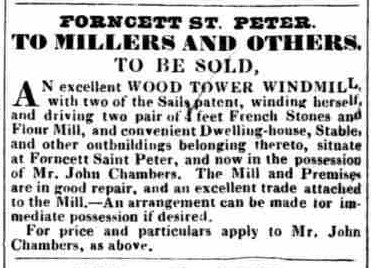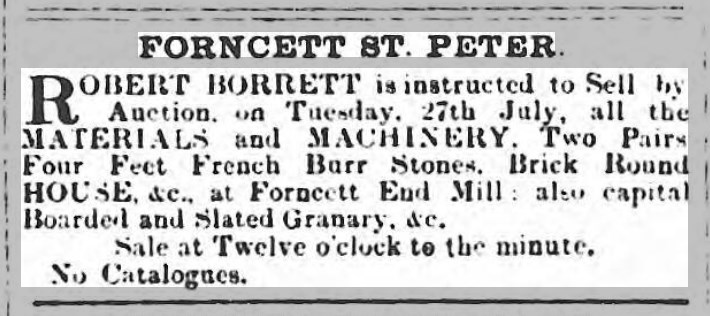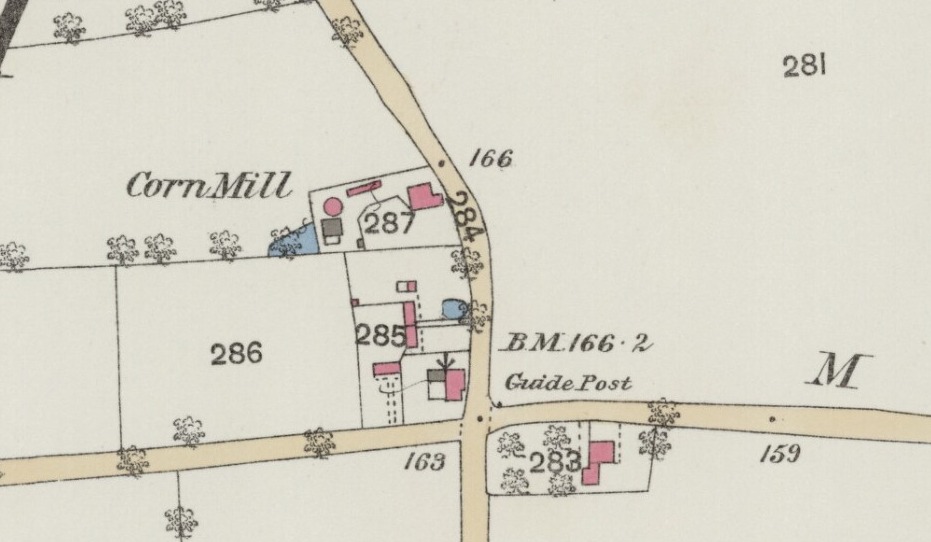Forncett Smock Mill
Forncett Smock Mill
There was apparently a windmill at the top of Mill Lane (now Mill Road) as early as the 16th Century, as a mill is shown here in the 1565 map published by Frances Davenport in her book "The Economic Development of a Norfolk Manor". Forncett smock mill is not shown on the Faden map of 1797 and first appears on a map of Forncett published in 1817 (see below). So it was presumably built between around the beginning of the 19th century.

We have no photographs of the Forncett smock mill but it probably looked similar to one at Winfarthing that was built in 1828 and worked until at least 1933 (see photo below).

A possible image of the Forncett mill can be found above the fireplace in the bar of the Jolly Farmers, in Forncett End, where a section of the mill post from the nearby White mill has been engraved with images of both a post Mill and a smock mill (see below).

The Forncett Tithe map of 1839 records the smock mill at enclosure 249, comprising a house, mill and garden in a total area of 16 perch. The owner was Thomas Hardy, a major landowner with more than 95 acres listed in the Tithe records. He owned, and probably lived at, Corner Farm in Low Road, Forncett St. Peter.
The miller was William Lent who was born in Tibenham in 1788 and came from a family of millers. William married Hannah Ludkin from Bunwell in 1813, but Hannah died in 1837 and so in the 1841 census William Lent (age 50) was a widower living with his son George (age 15) who was his apprentice, and his daughters Mary (15) and Martha (11). Sadly, William died intestate just one year later, in the first quarter of 1842, and the mill passed to his son George. In March 1842 George swore on a bond that his father is his lawful father and a widower. In 1843, administration was given to George Lent, miller of Forncett St. Peter, together with Joseph Lent (William's brother) & Timothy Lent (William's father), both millers in Tibenham. George and Joseph signed the administration and Timothy made his mark.
In subsequent years there were a number of different millers. In 1845, White's directory listed the miller as John Chambers but in 1850 the mill was for sale again. The sale advertisement described a "wooden tower mill" with two pairs of 4 foot French stones.

The 1854 edition of White's directory shows the mill to be in the hands of a Thomas Hardy, and the 1851 census for Forncett records that Thomas was a 28 year old miller, born in Forncett St. Mary, and employing two men. Thomas was the son of the Thomas Hardy who owned the mill in 1839.
The mill was offered for sale by auction again in September 1857, in June 1865, in August 1865 and in June 1867. So it seems likely that the owners (possibly still the Hardy family) were unable to sell it. At each sale William Bunting was shown as the tenant miller, paying a rent of £36 per annum. William was born in Attleborough in 1831 and he was helped (in the 1861 census) by a local lad, Lazarus Took.

Following the sale in 1867 it appears that William Bunting and his family moved to Fundenhall where they appear in the 1871 census. William and his son, also William, were then the millers at Fundenhall post mill from 1868 until about 1904.
The Forncett census for 1871 shows that the new miller at the smock mill was Benjamin Gibson (age 72) who worked the mill with his son Benjamin (age 28).

The Gibsons had previously lived at Mill House on Mill Lane in Aslacton and Benjamin had run the tower mill there for over 30 years. That mill is still standing today, albeit without its cap and sails. Benjamin Gibson snr. died in 1876 and his son took over the business as shown in the 1881 census. On 14th October 1881 the Forncett smock mill was severely damaged by a gale and the whole top of the mill was blown off and destroyed. What followed was a very early example of "crowd-funding" when the rector, Rev. Wilson, launched a fund to help Benjamin Gibson to repair his mill.

Norfolk News - 17th October 1881
The fund was apparently successful because Benjamin jnr. was still working the smock mill in 1883, as recorded in White's directory of that year, and the 1884 Ordnance Survey map shows a detailed layout of the mill and associated buildings.

However, in November 1885 Benjamin Gibson sold by auction all his household furniture as well as various agricultural tools and some animals.

The following July saw the sale of the mill machinery and the mill stones together with the round house and a granary. So we can safely conclude that Forncett smock mill had ceased working at the end of 1885.

Indeed, Kelly's directory of 1888 doesn't list Benjamin as a miller in Forncett and in the 1891 census he was no longer a miller but was working as an agricultural labourer back in Aslacton.
The reason for the mill's demise may well have been the construction, by Henry John Ludkin, of a new steam mill in Forncett End. Reference to this new mill appears for the first time in Kelly's 1888 directory; the same publication in which the smock mill is no longer listed. Nevertheless, the smock mill is still mentioned on the OS map published in 1898, suggesting that it was still standing then.
Exactly when the smock mill was demolished is not known. The
mill cottage was still standing in 1946 when it appears on an aerial view of the
crossroads (see below). However today the cottage has long since gone and the
enclosure in which it stood has been returned to agricultural land.



